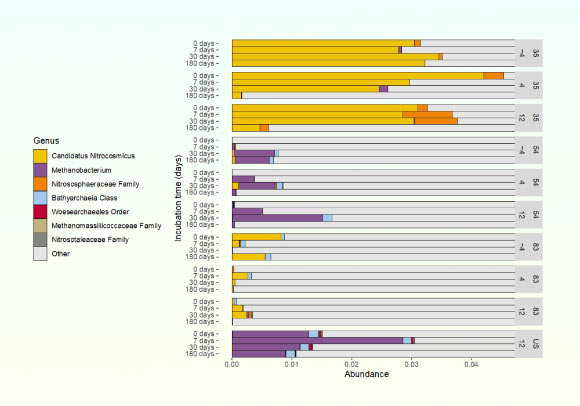Scientists have resurrected ancient microbes from permafrost cores of Late-Pleistocene age (up to 40,000 years old) collected from four locations within the Permafrost Research Tunnel near Fairbanks, Alaska. They’ve found that the microbes in thawing subsurface permafrost exhibit a slow ‘reawakening’ at first, but within six months the microbial community undergoes dramatic changes.

Abundance of Archaea across samples collected from the Permafrost Research Tunnel near Fairbanks, Alaska. Image credit: Caro et al., doi: 10.1029/2025JG008759.
Today, the world’s permafrost is thawing at an alarming rate because of human-caused climate change.
Scientists worry this trend could kick off a vicious cycle. As permafrost thaws, microbes living in the soil will begin to break down organic matter, spewing it into the air as carbon dioxide and methane — both potent greenhouse gases.
“It’s one of the biggest unknowns in climate responses,” said University of Colorado Boulder’s Professor Sebastian Kopf.
“How will the thawing of all this frozen ground, where we know there’s tons of carbon stored, affect the ecology of these regions and the rate of climate change?”
To explore those unknowns, the researchers traveled to a one-of-a-kind location, the U.S. Army Corps of Engineers’ Permafrost Tunnel.
This research facility extends more than 107 m (350 feet) into the frozen ground beneath central Alaska.
The scientists collected samples of permafrost that was a few thousand to tens of thousands of years old from the walls of the tunnel.
They then added water to the samples and incubated them at temperatures of 4 and 12 degrees Celsius (39 and 54 degrees Fahrenheit) — chilly for humans, but downright boiling for the Arctic.
“We wanted to simulate what happens in an Alaskan summer, under future climate conditions where these temperatures reach deeper areas of the permafrost,” said Dr. Tristan Caro, a postdoctoral researcher at Caltech.
The authors relied on water made up of unusually heavy hydrogen atoms, also known as deuterium.
That allowed them to track how their microbes drank up the water, then used the hydrogen to build the membranes made of fatty material that surround all living cells.
In the first few months, these colonies grew at a creep, in some cases replacing only about one in every 100,000 cells per day.
In the lab, most bacterial colonies can completely turn over in the span of a few hours.
But by the six-month mark, that all changed. Some bacterial colonies even produced biofilms that you can see with the naked eye.
“These microbes likely couldn’t infect people, but we kept them in sealed chambers regardless,” Dr. Caro noted.
“The colonies didn’t seem to wake up that much faster at hotter temperatures.”
“The results could hold lessons for thawing permafrost in the real world: after a hot spell, it may take several months for microbes to become active enough that they begin to emit greenhouse gases into the air in large volumes.”
“In other words, the longer Arctic summers grow, the greater the risks for the planet.”
“You might have a single hot day in the Alaskan summer, but what matters much more is the lengthening of the summer season to where these warm temperatures extend into the autumn and spring.”
“There are still a lot of open questions about these microbes, such as whether ancient organisms behave the same at sites around the world.”
“There’s so much permafrost in the world — in Alaska, Siberia and in other northern cold regions. We’ve only sampled one tiny slice of that.”
The results were published on September 23 in the Journal of Geophysical Research: Biogeosciences.
_____
T.A. Caro et al. 2025. Microbial Resuscitation and Growth Rates in Deep Permafrost: Lipid Stable Isotope Probing Results from the Permafrost Research Tunnel in Fox, Alaska. JGR Biogeosciences 130 (9): e2025JG008759; doi: 10.1029/2025JG008759







